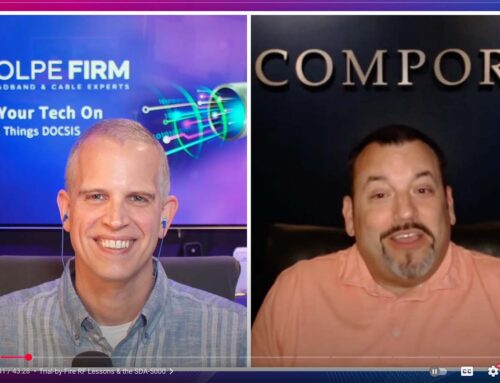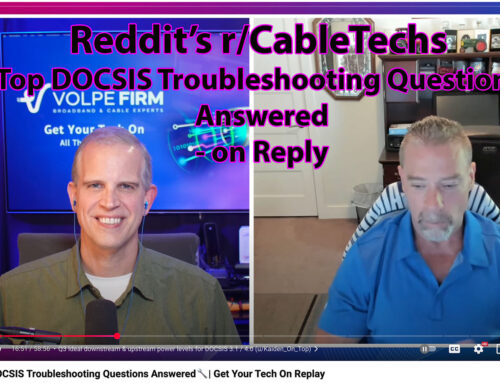Podcast: Play in new window | Download | Embed
Subscribe: Spotify | Email | RSS | More
Follow part 3 of this series on cloud native virtualization of DOCSIS and broadband networks? Brady Volpe and Asaf Matatyaou, Vice President, Solutions and Product Management, Cable Edge Business at Harmonic, explore this topic as it is becoming a big focus in the way we deploy and manage our networks through cloud native virtualization.
In this second installment we focus more on practical applications of virtualized CMTSs and answer more questions from our listeners. Part 1 of this series: https://youtu.be/IKbVYHYvrEc Part 2 of this series: https://youtu.be/eJVy573ASyM and Upcoming events: https://volpefirm.com/broadband-event/
Listen or watch Brady and Asaf discuss virtualization and what it means to cable systems and networks. Sounds like something that is off in the future but really it is in use today. Virtualization is not in the future or a nebulous term. Find out more about what is going on with virtualization. So many questions and we have the answers.
Virtualization a Deep Dive Part Three Outline:
- General intro
- General SCTE overview
- Symmetrical DOCSIS
- Address bandwidth pressures with software based approaches
- Speeds upstream 2.2 Gig and downstream 2.5 Gig
- Live deployments with 1.2 symmetric
- Pressure is in the upstream currently
- Fiber to the home is symmetrical Service is important for competition
- Lots of subscribers want more upstream speeds ~ 10 upstream
- Symmetry is very important to better service
- Cloud native virtualization – 4 things
- Kubernetes K8S,
- Containerization,
- pods,
- micro services
- Pod – unit of replication
- If we need additional capacity (fiber node or service group) adding another pod in a virtual environment rather than hardware ie – line cards. It’s easier and more cost effective.
- Another chases / Line cards have restrictions 85 MHz cut off
- New architecture required with hardware
- No fork lift upgrade needed with software
- Move split from 85 to 200 MHz. How is this done?
- The RF is still there – but now in DAA node FMA or Remote PHY
- Split configuration still in the Node
- Pluggable diplexers
- Programmable from the CORE
- Last edge piece is limitation
- Hardware in outdoor node enclosure etc
- Separate the diplex – hardware from the Remote-PHY device – software configurable from the split
- Chat room – FCAPs – Fault, Configuration, Accounting, Performance, Security
- Cloud Native – Fault and Security
- Helps with Fault tolerance
- How many subscribers will be impacted
- Fault tolerance is built into the software – service group – pod
- Also great for upgradeability
- Security – multi prone domain – several and many security capabilities
- Upgrade a container etc
- Kubernetes is great if something fails
- Lots of built in security with Kubernetes
- Blue screen of death – monitors – new windows install
- Containers with other containers = other services
- Much easier to do in software then hardware
- vCMTS
- sysmentric pon services
- Speed server / speed test
- It’s usually somewhere else – not in house
- Bring speed service in house – pod as a container in the cloud native cluster and not jump from outside source.
- Video capturing
- Content closer to subscribers
- Faster services – bring applications closer
- What if Kubernetes crashes
- haven’t heard of this yet
- redundant
- resilience in the platform
- Kubernetes cluster
- have multiple crashes but still have it up and running
- Highly fault tolerant
- Speed Test
- fiber node
- virtual CMTS
- at edge of network
- Speed test
- to node
- to RPD
- to edge of network
- Use Speed test – monitor congestion
- Speed test KILLER APP today
- The way we do speed test today is not optimal
- Speed test today can be 40 miles away from subscriber today
- Many hoops away
- WiFi
- Low Latency DOCSIS 2019 SCTE EXPO
- Has progress been made in 2020
- LLX standard / spec
- DOCSIS 3.1 LLX
- Latency jitter
- frames per second – videos, Netflix, virtual biking
- none q-building – gaming
- looking at traffic type to determine the traffic type
- Lab or real world 🌎
- customer labs
- Q1 Solution
- The internet is mission critical
- Manage pon in a Virtualization
- Runs in the same platform and is complimentary
- DOCSIS service group and co-exist with other deployments Fiber
- You can run several different services in virtualization
- REST API , DOCSIS, PON, ONT, ONU
- Can we configure PON the same from the CLI as vCMTS
End Podcast
Asaf thank you for your time today. This was a great episode. Our next Episode 69 in December 18th with John Downey.
You can watch us live or recorded on Youtube or listen to us on your favorite podcaster. Links to everything is on the volpefirm.com webpage.
If you have enjoyed this webcast, please do hit the subscribe button so that you never miss an episode.
Thank you so much for being here and we will see you next month.
Upcoming events can be seen under Broadband Events. Previous events can be seen under the blog.
- If you are watching this on youtube please hit the subscribe button!
- Let us know what you think and remember to share!
- You can find slides at the bottom of the page and some on slideshare.
- Find out about events or articles by following us on Twitter, LinkedIn or Facebook too.
Also available on iTunes, Google Podcasts, Spotify, vurbl see podcasts “get your tech on”.





Leave a Reply